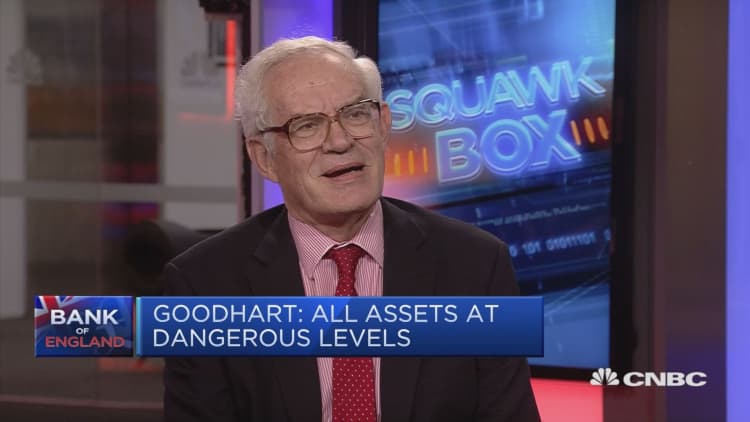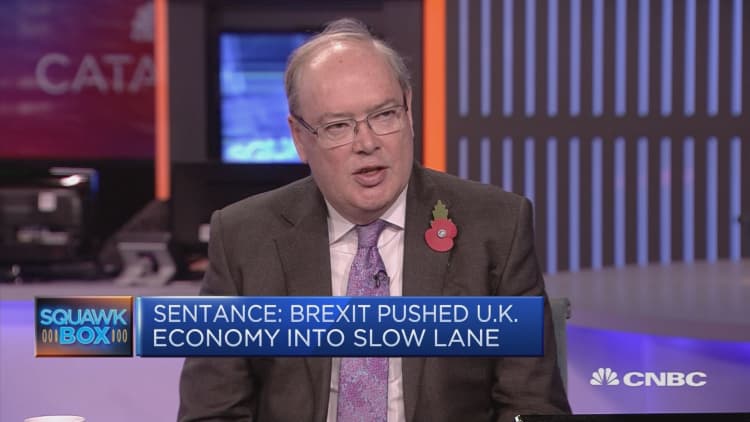
The Bank of England (BOE) is widely expected to raise interest rates from record lows Thursday, but market participants will be closely watching for clues on what the U.K. central bank will do next.
This will be one of the BOE's most significant meetings in some time — not only because of the likely rate move but because of the what the market will glean from this.
The central bank has remained ultra-accommodative in the years since the global financial crash and also introduced U.S.-style quantitative easing (QE) — buying assets to stimulate lending — which is used to stoke inflation and boost the economy. Shortly after the Brexit vote last year it pushed rates even lower, anticipating a sharp decline in consumer spending.
But, the central bank strongly indicated in September that it is ready to reverse this policy of easing, hiking rates from the emergency low level of 0.25 percent — more than a decade after the U.K. saw its last interest rate hike. The bank's benchmark interest rate is crucial for the economy as it is used to price all sorts of bank loans and mortgages.
In fact, an increase has been so widely telegraphed to occur Thursday that the market has a 25-basis point move priced in with more than 85 percent probability.
So what else is there to watch out for?

While the majority of economists are calling for a 6-3 split from policymakers in favor of a hike, (naysayers being Deputy Governor Jon Cunliffe and newer members Dave Ramsden and Silvana Tenreyro), a more uneven tilt to the committee would send hawkish signals to the market and suggest that the hiking cycle from here may be faster than what the market has priced in.
However, some traders in the bond markets suggest that a 7-2 split is what is embedded into expectations here (so a slightly more hawkish lean than economist expectations). As of now, the market indicates a total of two hikes (50 basis points) by November 2018, a total of 75 basis points by March 2020, and 100 basis points by sometime in 2022. This implies only one further hike next year followed by a subsequent hike only 18 months later. This would be considered a shallow hiking cycle versus what the BOE has done in previous hiking episodes.
Sterling to move higher?
In the currency markets, foreign exchange strategist Viraj Patel at ING thinks sterling would only move lower if there were "more than two dissenters or an explicit statement ruling out another rate hike in the near term," adding that the "latter option seems highly unlikely and somewhat inconsistent with the typical central bank forward guidance." ING predict the pound will be at 1.35 against the dollar year-end. It's currently trading at around 1.3283.
Some market participants believe that one of the main motivations for hiking rates would be to dampen the appreciation effects the weaker currency has had on inflation though analysts at Bank of America Merrill Lynch dismiss that concept as "it is not their mandate and that it would only work if hikes come in response to a better economic outlook, which is not what the U.K. currently faces."
Growth forecasts
Most analysts are expecting little or no revision to the growth forecasts. The 0.4 percent quarter-on-quarter third-quarter gross domestic product (GDP) print last month points to a yearly forecast only slightly higher than what the Bank of England has penciled in already.
Citi analysts point out that another 0.4 percent quarter-on-quarter print in the fourth quarter would still not be enough to deliver the 1.7 percent GDP growth the BOE is currently expecting, so will likely stick to the 2017 forecast for now.
Inflation forecast
The forecast that could really move the needle. The CPI (consumer price index) print for September hit 3 percent and the expectation is that it may climb to 3.1 percent in October before leveling off again once currency related passthrough effects start subsiding. An inflation overshoot above 3 percent would mean that the BOE Governor Mark Carney would have to write a letter to the U.K finance minister explaining the overshoot.

Citi analysts believe that uptick in inflation could help justify a rate rise and an upward revision of fourth quarter 2017 inflation in the short run.
However, market participants should look out for the two and three year-ahead forecasts. Here, Deutsche Bank analysts see both dovish and hawkish catalysts. For the latter it says that healthy labor costs and employment demand could lead to an unchanged forecast of around 2.2 percent by the Bank for both these forecasts.
A forecast still above the BOE's target of 2 percent would suggest that the current interest path priced in by the market will not enough to bring inflation back to target and therefore more hikes would likely be warranted.
Forward guidance and Brexit
Other items to watch out for include the language around forward guidance and whether Carney will choose to emphasize a "gradual" tightening path or suggest that more hikes may be coming (either directly or indirectly via the forecasts).
And lastly, the only reference to Brexit is a current passage in the meeting minutes citing that the policy committee will respond to "developments" in the "EU withdrawal process," insofar as they affect the forecasts. Carney will likely be questioned on this matter during the press conference on Thursday afternoon. Having recently given a speech at the International Monetary Fund arguing that Brexit could be inflationary in the short term, the market will likely want to find out how much of the new forecasts hinge on the U.K. securing a transitional deal for Brexit as we edge closer to a December "make or break" EU leaders summit.
While a hike is almost a done deal, one thing we know for sure is that it's going to be a Super Thursday after all.


